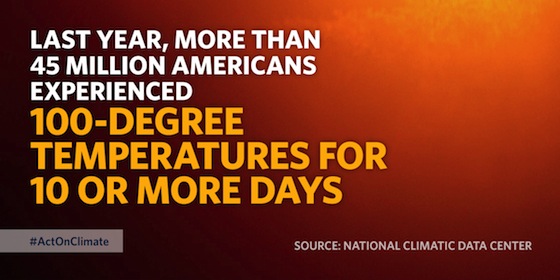
A year ago today, hundreds of the country’s top climate scientists confirmed that climate change is affecting every region across America in the third U.S. National Climate Assessment (NCA) – the most comprehensive scientific report on domestic climate change impacts ever generated. Since then, communities, localities, and states have continued to use scientific information from the NCA and elsewhere to inform action and make resilience-related decisions on the ground.
Today, in an effort to shine a light on the extraordinary work being done at the regional level and to better understand and address local scale climate-change impacts, President Obama’s Science Advisor John Holdren spent the day with community leaders, scientists, and students at the University of Nebraska—Lincoln (UNL), where researchers are conducting cutting-edge work to develop and deploy actionable climate science.
In 2014, UNL leveraged information from the third NCA to develop its own report, Understanding and Assessing Climate Change: Implications for Nebraska. This state-focused scientific assessment is aimed at ensuring businesses, communities, decision makers, and citizens across Nebraska have the best available information about climate impacts occurring in their own region.
That’s just one example of the many ways communities and regions are taking steps to translate science into actionable information where it matters most – America’s towns, cities, and communities.

The Obama administration is continuing to do its part to facilitate these localized efforts. Based on tremendous positive feedback from stakeholders and decision makers about the utility of the NCA for their work and planning, the interagency U.S. Global Change Research Program (USGCRP) is conducting a “sustained assessment” process to provide the nation with scientific information about climate change on an ongoing basis.

This effort is focused on enhancing the federal government's ability to deliver timely, scientifically rigorous products that can support climate preparedness and resilience decisions across the country. It is also helping foster collaboration among decision makers at the national, regional, tribal, and local levels. Broad public participation is a cornerstone of this effort, which includes a number of new and ongoing activities to collect feedback and inform decisions on the ground:
-
The U.S. Global Change Research Program is issuing a Request for Information, seeking ideas and feedback from the public on how this sustained assessment process can best support the nation’s need for scientific information about climate change.
-
In addition, drawing on efforts underway across several agencies, USGCRP is also releasing a pilot set of climate change indicators that visually communicate some of the key aspects and effects of the changing climate. Diverse feedback is also needed on this pilot effort, to inform development of a more comprehensive system that can provide decision makers with the real-time information they need to plan for the impacts of climate change.
-
USGCRP recently released a draft report on the impacts of climate change on human health, which is currently available for public review and comment. Future topic-specific reports will be made available in key areas of interest to ensure that stakeholders are getting the information they need.
- Today the U.S. Environmental Protection Agency is releasing an online training module to help local government officials take actions to increase their communities’ resilience to the impacts of climate change. The virtual training, which was informed by the third National Climate Assessment, is the latest addition to the U.S. Climate Resilience Toolkit, which provides easy access to resources and tools to help decision makers understand and prepare for climate-related hazards. The training features examples of effective resilience strategies that have been implemented in cities and towns across the country, and will help local governments make smart decisions in the face of a changing climate. This training was informed by recommendations from President Obama’s State, Local and Tribal Leaders Task Force on Climate Preparedness and Resilience and with advice from EPA’s local Government Advisory Committee.
Tamara Dickinson is Principal Assistant Director for Environment and Energy at the Office of Science and Technology Policy.

